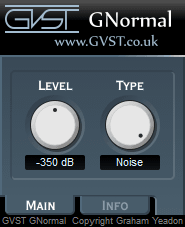GNormal Manual
Welcome to GNormal
GNormal tries to remedy denormal problems by introducing extremely low-level noise to the signal path. (If you don't know what that means, then you probably don't need GNormal).
Some CPUs employ techniques to extend the accuracy of floating-point calculations involving very small numbers. These small numbers are called denormals.
Unfortunately, calculations involving denormals can be very slow, drastically affecting audio DSP performance; and in most cases the numbers involved are too small to be of any interest anyhow.
Adding noise to the signal path can prevent denormals from reaching subsequent calculations by keeping the signal level above the denormal range. The level of the noise added is so low that it is inaudible.
Installation
- All GVST plug-ins come compressed in a ZIP file, so the first step is to extract the files from the ZIP file.
- Once extracted, you should have one or more DLL files, these are the plug-in files.
- You need to copy the plug-in files to the appropriate folder for your host program.
- In most cases, you will need either to restart the host program or re-scan the plug-in folder in order for newly-installed plug-ins to appear.
Hints
- The simplest way to configure GNormal is to place it before a suspect plug-in and set the "Level" parameter to maximum. Try each setting of the "Type" parameter to see if the problem goes away. When you have found a suitable noise-type, you should reduce the noise-level as much as possible.
Interface

The GNormal GUI has two knobs to control the two parameters.
Level: The maximum peak level of the generated noise.
Type: The type of noise generated. Some noise types are ineffective in particular circumstances. For example, "AC" noise will be removed by a low-pass filter. The only way of knowing which will work for a given plug-in is by trying them.
- DC: A constant value is added to the signal.
- AC: Like DC except that the sign of the added value flips every sample.
- Square: Like AC except that the sign flips less frequently, forming a square wave shape.
- Pulse: Occasionally adds a single value at the set level followed by zeroes.
- Noise: Adds white noise to the signal.
License
- GVST plug-ins are provided to the user at no cost. While every GVST plug-in is tested to the best of the developer's ability, no warranty or guarantee is offered to the end user.
- No suggestions made by the developer or his representatives (i.e., freely offered support) are to be taken as an implied warranty or guarantee.
- These plug-ins may only be distributed by the official GVST website, or by parties explicitly given permission by the developer.
- GVST plug-ins are to be distributed only in their original form as intended by the developer (i.e., the unaltered archive).
- GVST plug-ins are freeware, meaning you are never under any obligation to pay for them! However, should you wish to help support continued development of GVST software, please consider donating through the official website.
Credits
- Development, code, website and graphics by Graham Yeadon.
- Documentation by Greg Pettit and Graham Yeadon (many thanks to Greg for all of his help).
- VST technology copyright Steinberg GmbH.
- The "VST" name and logo are registered trademarks of Steinberg GmbH.
- "Windows" is a registered trademark of Microsoft Corporation.
- "Mac" and "OSX" are trademarks of Apple Inc.
